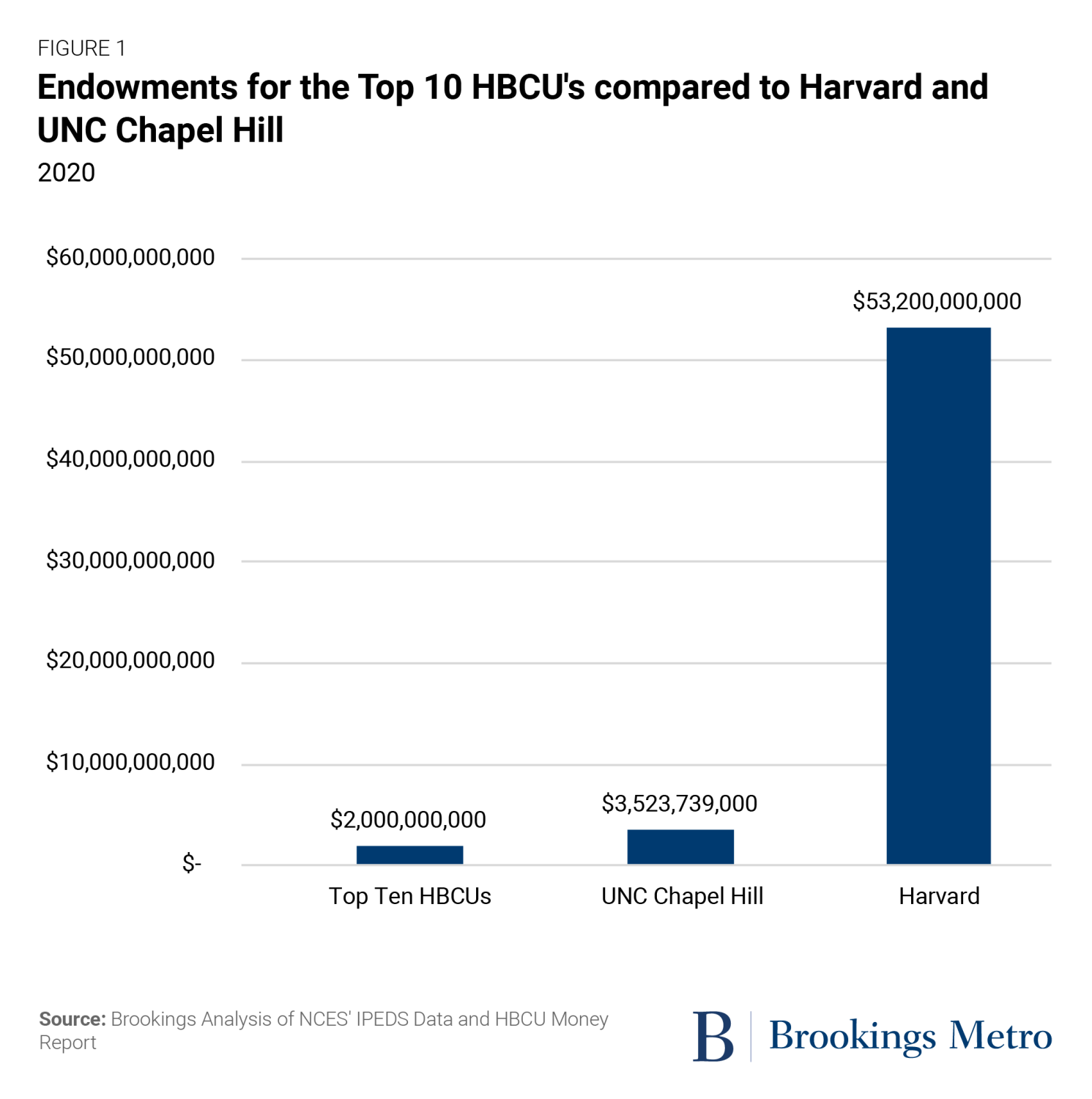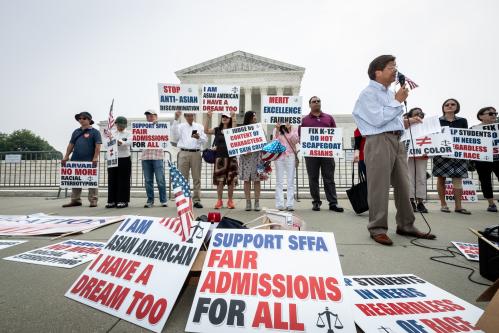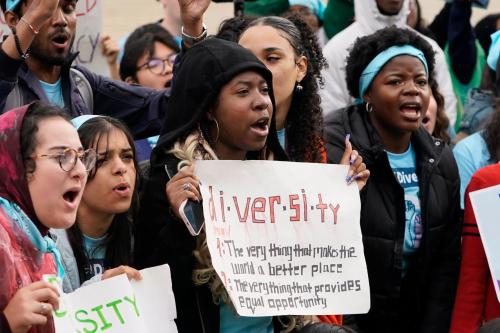The June 29 Supreme Court decision on affirmative action effectively ends race-conscious admissions practices in higher education and erodes 40 years of precedent. In a 6-3 ruling, the majority used the equal protection clause of the 14th Amendment—which was created to rectify the inequality faced by Black Americans—to disband the practice of race-conscious admissions. This decision in favor of neutrality denies the nation’s history of racial injustice, and as Justice Ketanji Brown Jackson stated in her dissent, “condemns our society to never escape the past that explains how and why race matters to the very concept of who ‘merits’ admission.”
The decision will most likely result in declines in racial diversity among many public and private postsecondary institutions, which means that some of the most talented students of color will have to pursue a postsecondary degree elsewhere. Historically Black colleges and universities (HBCUs) can help fill this gap. HBCUs have developed talent that other institutions turn a blind eye to, and in the face of the Court’s decision, society will demand that these schools educate even more students. But for HBCUs to meet that demand, these systematically devalued institutions must receive greater investment.
Ending affirmative action erodes racial equity in higher education
The case before the Supreme Court began in 2014, when a group called Students for Fair Admissions filed lawsuits against Harvard and the University of North Carolina at Chapel Hill, claiming that the universities practice discriminatory quota systems that unfairly penalize Asian American and white students. Harvard and UNC argued that they were exercising their constitutional and moral right to set diversity goals and consider race in admissions decisions in order to reach them. But today’s ruling establishes that among the many factors that go into admissions decisions, the use of race “must comply with strict scrutiny, may never use race as a stereotype or negative, and must—at some point—end.”
Previous state-level affirmative action bans have shown that race-neutral admissions policies are ineffective at improving racial equity in higher education. One study found an immediate 1.6-percentage-point decrease in Black enrollment in the most selective schools after such state-level bans. School leaders in some of these states filed amicus briefs to the Supreme Court in support of affirmative action, stating that their schools’ Black enrollment has dropped and remained lower than pre-ban levels after more than a decade. And now, minority enrollment is predicted to decrease by as much as 10% in highly selective colleges following the elimination of race-conscious admissions nationwide.
The end of affirmative action is, as colleges and universities have warned, a major blow to their ability to tap into the full spectrum of student talent. Systemic barriers such as underfunded schools, housing discrimination, and income inequality can prevent even the most talented students from attaining higher education. Without affirmative action to help students from underrepresented groups overcome these systemic barriers, fewer Americans will be able to maximize their participation in the economy and democracy.
HBCUs are positioned to fill the gap
Students of color have been in this situation before. For most of American history, postsecondary institutions have been exclusive. Harvard—the nation’s oldest higher education institution, founded in 1636—did not admit a Black student for over 200 years, and admitted Black female undergraduates only after the Supreme Court legalized affirmative action in 1978. The University of North Carolina did not even accept Black applicants until the 1950s, and has yet to see its Black enrollment reach the same share as the state’s Black population, which is 22.3%.
With the Court’s decision likely to lead to Black enrollment declines at selective, predominately white institutions, HBCUs are positioned to step in. Although HBCUs represent only 3% of all four-year institutions, they account for 10% of all matriculating Black students, and awarded 17% of all bachelor’s degrees and 24% of all STEM-related bachelor’s degrees to Black students in 2019. HBCUs also enroll more than twice as many Pell Grant-eligible students as non-HBCUs. And while HBCUs saw their enrollment numbers increase during the COVID-19 pandemic, this upsurge may prove challenging as Black institutions—like Black people—are under-resourced due to past and present discrimination.
Recently, HBCUs have been working to correct those injustices. In 2021, Maryland paid $577 million to the state’s four HBCUs to settle a 15-year-old lawsuit alleging a discriminatory funding system that favored traditionally white schools. A similar situation is currently unfolding at Tennessee State University. And last year, HBCU students in Florida filed a lawsuit against the state claiming that public predominately white institutions were replicating HBCU programs without accountability, luring away funding and students.
We must invest more in HBCUs to help students succeed
In a previous report, we found that in 2020, the 10 largest HBCU endowments were 100 times smaller than the 10 largest endowments for predominantly white institutions. Even the combined total of every HBCU endowment in the country—roughly $3.9 billion in 2019 —was less than New York University alone ($4.2 billion). Figure 1 shows how Harvard and UNC’s endowments also dwarf the top HBCU endowments.

Additionally, less than 1% of federal research and development grants are awarded to HBCUs. This lack of investment translates into fewer resources for students and faculty. With demand for HBCUs poised to jump in the wake of the Supreme Court decision, states, corporations, philanthropies, and individuals need to reprioritize investment in these institutions.
Brookings Metro previously discussed this need in the aforementioned report, A call to action for HBCU investment. We stated that while philanthropic and corporate pledges for Black scholarship are welcome, they are not sufficient given systemic devaluation and past discrimination, which also results in a lack of access to capital markets. As we wrote in the report, “HBCUs need routine access to investment capital from a range of sources, including traditional banks, community development financial institutions (CDFIs), philanthropy, and other trusted, mission-driven partners that will enable long-term planning for institutional development and expansion.”
To scale their impact, HBCUs must receive revenue from community and economic development activities that are external to the institution. Returns from these external investments can bolster HBCUs’ bottom lines and strengthen the surrounding communities. For example, revenue from land and property acquisition as well as the commercialization of research, patents, and entrepreneurial activity can boost endowments, and also be reinvested into students and faculty.
The Supreme Court’s decision to strike down affirmative action has pushed higher education into a new paradigm, potentially leaving students of color sidelined. HBCUs can fill the gap, but only if society invests in them in ways that recognize these institutions’ value in advancing democratic ideals and human potential.






Commentary
The Supreme Court’s decision to strike down affirmative action means that HBCU investment is more important than ever
June 29, 2023